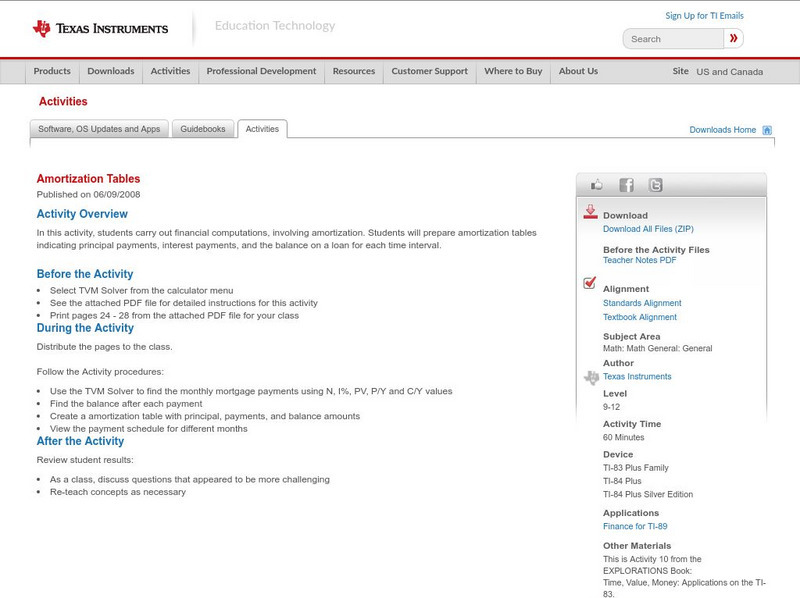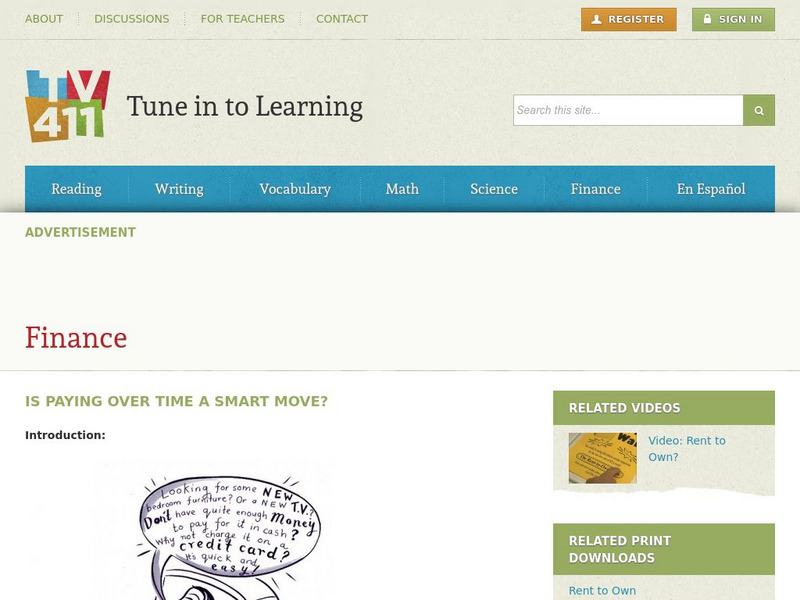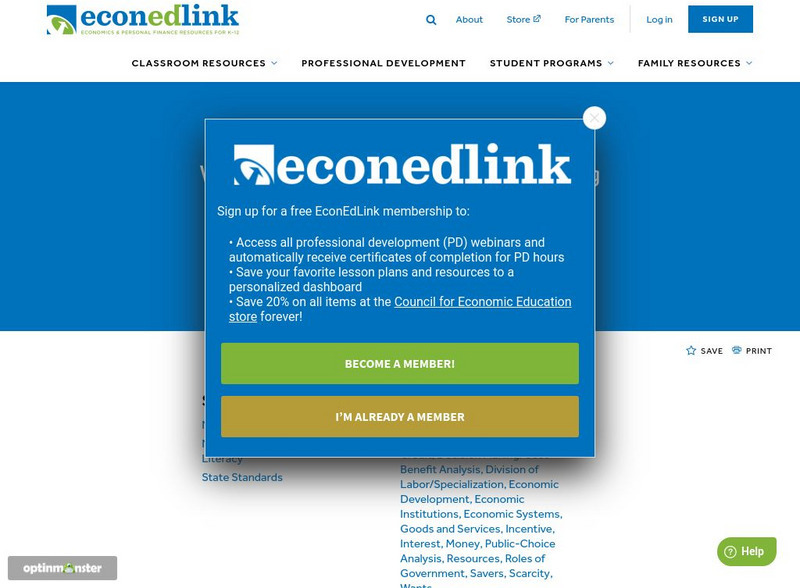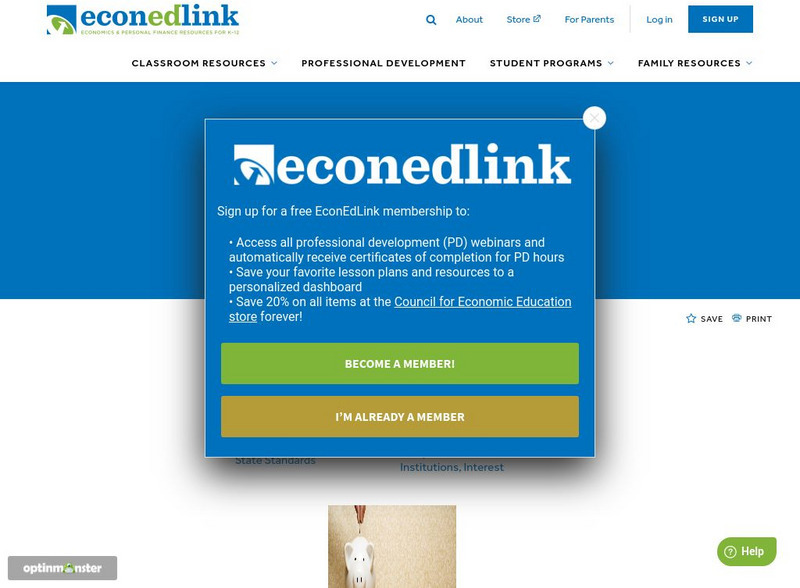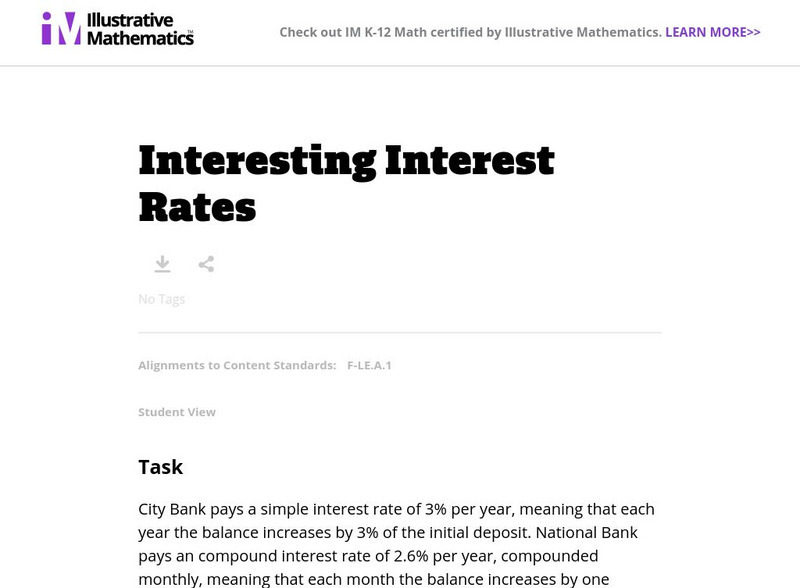CK-12 Foundation
Ck 12: Arithmetic: Simple Interest
[Free Registration/Login may be required to access all resource tools.] In this lesson, students solve real-world problems involving simple interest by using problem-solving strategies. Students examine guided notes, review guided...
CK-12 Foundation
Ck 12: Arithmetic: Simple Interest
[Free Registration/Login may be required to access all resource tools.] In this lesson students use simple interest to solve real-world problems. Students examine guided notes, review guided practice, watch instructional videos and...
CK-12 Foundation
Ck 12: Analysis: Simple and Compound Interest
[Free Registration/Login may be required to access all resource tools.] Students solve real-world problems involving simple and compound interest. Students examine guided notes, review guided practice, watch instructional videos and...
Texas Instruments
Texas Instruments: Amortization Tables
In this activity, students carry out financial computations, involving amortization. Students will prepare amortization tables indicating principal payments, interest payments, and the balance on a loan for each time interval.
Education Development Center
Tune in to Learning: Is Paying Over Time a Smart Move?
At T.V. 411 you can explore the concept of paying over time with situations involving credit cards, rent to own items, and more. This interactive lesson gives the learner an opportunity to make decisions about money management.
Council for Economic Education
Econ Ed Link: You Can Bank on This! (Part 3)
Building on the first two lessons in the series, this lesson deals with savings and interest. This is the Teacher Version. There is also a link to the Student Version.
Council for Economic Education
Econ Ed Link: What's My Interest?
Students explore the concept of interest by means of two activities. The first, a simple activity with jellybeans, introduces the concept of interest accruement, and the second, a practical, "real world" activity, reinforces the concept...
Council for Economic Education
Econ Ed Link: You're Going to College
The students will explore the costs and the benefits of going to college. They participate in a three-part game designed to help them understand the decisions associated with attending college and the benefits available to college...
Council for Economic Education
Econ Ed Link: Work, Earnings and Economics: Using Lyddie by Katherine Paterson
In reading and discussing Lyddie, by Katherine Paterson, students examine basic economic concepts and explore the growth of labor unions and the role of government in a market economy.
Purple Math
Purplemath: "Investment" Word Problems
Demonstrates in a systematic way how to set up and solve 'investment' word problems.
Council for Economic Education
Econ Ed Link: Compound Interest
Video [2:52] and quiz on the concept of compound interest.
Council for Economic Education
Econ Ed Link: Big Banks, Piggy Banks
Use this informative economics lesson plan. Find out how to save your money. "You will read about safe places for keeping money; you also will learn about places where money can earn money."
Council for Economic Education
Econ Ed Link: Big Banks, Piggy Banks
When choosing a place to put their money, people consider how safe there money will be, how easy it is to access, and whether it will earn more money. Students explore how well different savings places achieve these objectives. This...
Council for Economic Education
Econ Ed Link: Calculating Simple Interest
How do banks calculate the amount of interest paid on a loan? In this lesson, students will view a Livescribe Pencast to learn how to find the dollar amount in interest that is due at maturity. This lesson uses different time periods...
Council for Economic Education
Econ Ed Link: You Can Bank on This! (Part 4)
This instructional activity deals with credit, and wraps up this unit on finance.
Council for Economic Education
Econ Ed Link: Banking Is Interest Ing!
Banks are important to Americans. We use banks to save money and earn interest, or borrow money and pay interest. This lesson introduces the concepts of banking to children.
Council for Economic Education
Econ Ed Link: The Benefits of Investing Early
The students will see how compounding returns make investing at a young age pay off.
Council for Economic Education
Econ Ed Link: Compound Interest Calculator
The activity investigates compound interest, principal, and interest. Students can calculate different savings over time by inputting the monthly savings, starting age, and interest rate. The learning tool includes a graph that shows the...
Council for Economic Education
Econ Ed Link: Opportunity Cost
Consumers are faced with tough choices because so many innovative and exciting products and services are available. Therefore, engraining a decision-making process that includes considering of opportunity cost is necessary to shape...
Council for Economic Education
Econ Ed Link: Should I Use Cash or Credit?
This is a lesson presented by EconEdLink that delivers the dilemma of cash or credit. Includes background information, a problem-solving grid, and great questions.
Goodwill
Gcf Global: Banking Options
Tutorial explores numerous banking options to help you can make the right choice.
Illustrative Mathematics
Illustrative Mathematics: F Le Interesting Interest Rates
For this task, students work with simple and compound interest rates to determine which bank offers the best return on a deposit. Aligns with F-LE.A.1.
Council for Economic Education
Econ Ed Link: Timing Is Everything
In the first part of the lesson, students examine the incentives and opportunity costs of spending and saving in a teacher directed lesson. The remainder of the lesson is an interactive website. Students work through problems that...
Council for Economic Education
Econ Ed Link: A Penny Saved Is a Penny at 4.7% Earned
This is a lesson from EconEdLink where students learn about saving money. Includes activities and materials.





